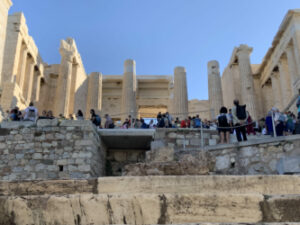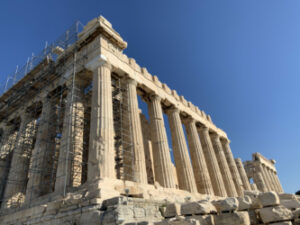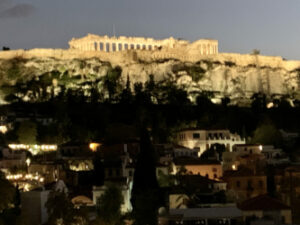A single missile shot into the bright blue sky, arched toward the hill across the valley, curved down in a perfect trajectory and slammed into the cache of gunpowder in the huge Greek temple. The explosion thundered through the hall, ripped off the roof, destroyed walls and tore off the marble carvings. When the dust settled, the Parthenon lay in ruin. The year was 1687, and the temple had stood in Athens largely unchanged for 2000 years but in that instant, it was nearly destroyed. The symbol of Ancient Greek culture from the days of Pericles, Socrates, Aristotle and Plato, the bedrock of Western civilization, was badly damaged. Yet amidst the rubble, the temple retained a certain magic.

With deference to Beethoven, the Parthenon is an Ode to Joy in stone, its perfect proportions still visible. The ruined parts seem to lend it a degree of mystery and intrigue. Despite its condition, the droning of the construction cranes, and spare bits and pieces of stone stacked everywhere, nothing diminishes the Parthenon’s grandeur.
In fact, the complex design of the structure is even more surprising than its beauty. The pillars are not straight as they appear but fatter in the middle and lean in toward the center. Even the steps, which look flat, are higher in the middle than on the ends. If the Greeks had made everything straight and flat, the eye would have distorted the appearance and made them look saggy and ill proportioned. To think the Greeks were aware of this ocular distortion and knew how to overcome it 2500 years ago, is a testament to their genius.

The temple, ¾ the size of a football field, was constructed of limestone and marble blocks, each weighing several tons. These blocks were transported from a quarry 10 miles away and hauled up to a plateau 500 feet above the city, all without diesel engines and steel cranes. The columns, which appear to be one 5 story tall pillar of stone, are more like stacked checkers pieces with seams so perfect they are almost invisible. Below the roof line were the famous marble carvings, half of which are in the British Museum in London, taken there by Lord Elgin over 200 years ago ostensibly to preserve them. Inside was a 5 story statue of Athena herself, stolen and destroyed centuries ago.
In 470BC when the Parthenon was built, this plateau was filled with hawkers, politicians, priests, royalty, soldiers and peasants, a public square alive with the vibrancy of the city. None would have had any idea that their new temple would become a world-recognized icon centuries later. Today it is still crowded but by groups of admirers. I explained all this to my group of travelers. Although these facts don’t increase the loveliness of the temple, they add to the appreciation of it.
Some visitors will know nothing about the Parthenon and still marvel at its beauty. Historical knowledge isn’t required for admiration. Standing before Van Gogh’s painting ‘Starry Night’, it isn’t necessary to know the name of the bay or town it depicts or that Van Gogh might have been in mental agony when he painted it. It is beautiful simply because it is beautiful.

Of course, history gives more context and meaning. The story of the missile and the gunpowder explains the destruction, but not why it was a Venetian rocket or Turkish gunpowder in a Greek city. The fact is, Turkey controlled Athens in 1687 but Venice wanted it, a story old as time. Reconstruction will restore the roof, the walls, and the marble carvings, to how the Parthenon appeared one minute before the explosion. The Athenians, I was told by several, think some of the myth and magic will be lost.
That night from the rooftop bar of the Hotel Plaka, I stood with my group and gazed up at the illuminated temple, its golden pillars rising majestically into the inky darkness above the twinkling city. Glowing in the soft spotlights, the Parthenon seemed to levitate. We sipped our drinks and after a moment or two no one spoke. For me, it was enough just to stare and listen to Beethoven’s Ode to Joy in my head.
